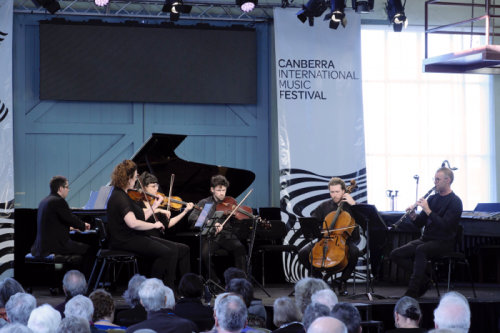
Music / CIMF, Concert 19 – “Bach in Africa”. At the Fitters’ Workshop, May 11. Reviewed by HELEN MUSA.
THE director of the Canberra International Music Festival, Roland Peelman, was drawing a long bow when he linked African music to Johann Sebastian Bach on the strength of a comment by Albert Schweitzer, but he got away with it.
Schweitzer had once said, “Bach is thus a terminal point. Nothing comes from him; everything merely leads to him,” and few could argue with that. But the clever juxtaposition of Bach with traditional West African kora music played by Griot bard Lansana Camara and the “G’day Africa” series by Australian composer Moya Henderson, made the point loud and clear that Bach is not the only musician to have achieved high degrees of intricacy.

The concert began quietly with “Contrapunctus II” and “Contrapunctus IV” from Bach’s “Art of Fugue,” BWV 1080, performed by Penny Quartet — Amy Brookman and Madeleine Jevons on violin, Anthony Chataway viola and Jack Ward on cello.
But it was only when Camara began to perform on the kora that Peelman’s purpose was evident. The delicacy of this music, performed on 21 strings, is hard to over-estimate, and as the audience became attuned to the melodic patterns, the sheer complexity of the songs became evident.
My only reservation would be that Griot is in the troubadour tradition, so it would have helped if the large upstage screen had been used to project the words of the songs.
Central to Peelman’s programming was the performance of “G’day Africa” Parts I, II and III and an entirely new composition in the same series, commissioned by Dr John Davies after an idea had been hatched by Peelman to write a fourth “G’day Africa” for an expanded ensemble.

Henderson was strongly influenced by Zulu and Basotho music she had heard when she was a composition student, immediately enthusing to the lilting, melodic patterns and complex, driving rhythms of this music
She went on in 1990 to create “G’day Africa I” in homage to the release of Nelson Mandela, placing the clarinet front and centre. In this concert that part was performed eloquently by Jason Noble. This was also to be the case in “G’day Africa” Parts II and III, although in Part III, the viola, played by James Wannan, achieved greater prominence.
Throughout these first three sections, the percussive effects were provided by Peelman at the piano, sometimes rocking to the music, and by cellist Blair Harris.
Before the world premiere of “G’day Africa IV”, pianist Edward Neeman gave an accomplished performance of “Canon alla Duodecima” from “Art of Fugue,” BWV 1080, reminding us what the concert was all about.
Henderson’s newly commissioned composition was performed by the combined forces of the Penny Quartet and Noble on clarinet, with Neeman performing the challenging piano part with infinite ease.
This broader orchestration, I felt, lacked the rhythmical impact of the first three parts, but the audience rewarded composer Henderson with an enthusiastic ovation, then welcomed Camara back to centre stage to perform a cora encore.
Who can be trusted?
In a world of spin and confusion, there’s never been a more important time to support independent journalism in Canberra.
If you trust our work online and want to enforce the power of independent voices, I invite you to make a small contribution.
Every dollar of support is invested back into our journalism to help keep citynews.com.au strong and free.
Thank you,
Ian Meikle, editor




Leave a Reply